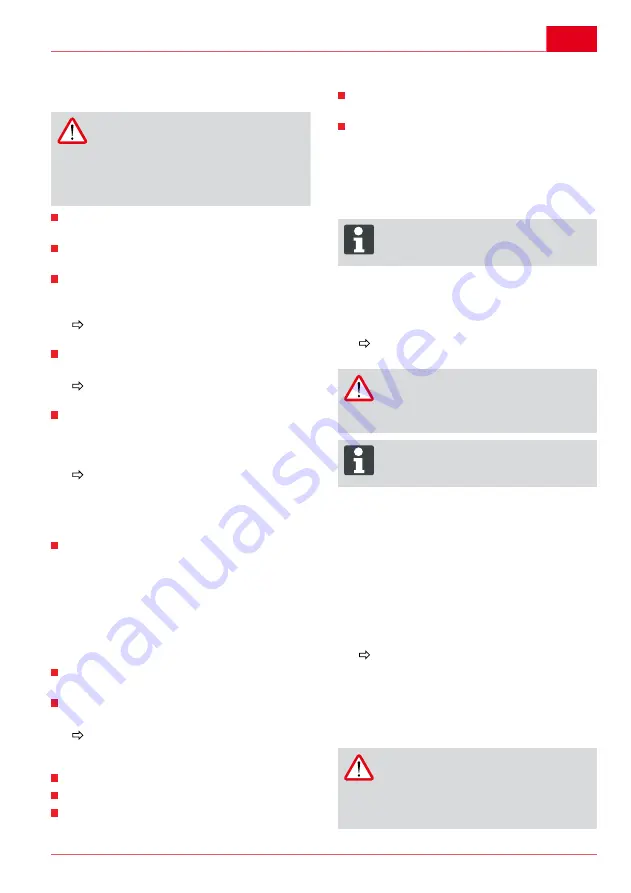
en
** acc. to DIN EN 13157 (7-times safety for the strap required)
SAFETY INSTRUCTIONS
CAUTION!
Danger of brake release!
The load pressure brake can release
due to vibration. The cable winch should
not be used to secure loads! Do not re-
move the crank while under load!
Danger of fatal injury! - Never stand under
suspended loads!
Risk of accidents! - Do not activate the locking
switch while under load!
Risk of accidents! - The brake system can
overheat during extended lowering of loads.
No continuous operation!
Maximum lowering duration 2 - 5 minutes
depending on the load.
Risk of accidents! - Do not operate the cable
winch if the locking switch is damaged!
The crank could otherwise be inserted
when the braking function is switched off.
Only use ropes for which the hook is firmly at-
tached to the rope via a pressed rope loop.
End connections according to EN 13411-3,
with thimbles according to 13411-1.
If not otherwise stated in the EN stan-
dards listed above, the rope connections
must be able to withstand a force of at
least 85% of the minimum breaking force
of the rope without a break!
Hook and connecting device (triangle) must
offer 4-times safety with cables and straps. No
permanent distortion is allowed under static
load with 2-times the nominal load. At 4-times
static load, bending open or deformation is
permitted, however the load must still be se-
curely held (see EN 13157). Alternatively, a
hook acc. to EN 1677-2 with guaranteed safe
working load must be used.
Sharp edges! Damage from scrapes, crus-
hing, cuts. Always wear work gloves.
Observe the required breaking load when
using a strap.
The breaking force of the stitched strap
must be at least 7 times the specified ten-
sile force in the lowest cable position.
Do not knot together ropes / straps.
Do not expose straps to acids or bases.
Use a cover to protect straps from moisture
and constant solar radiation.
Do not exceed the tensile forces specified in
the technical data.
Always used non-twisting or low-twisting ro-
pes for lifting a freely suspended load that
could rotate during the lifting procedure!
INSTALLATION
Installing the crank handle
The crank handle can only be installed
with the automatic rolling mechanism lo-
cked.
1. Lock the automatic rolling mechanism (
Fig.
1-1
).
2. Pull back the locking sleeve (
Fig. 1-2
).
3. Push on the crank handle.
Check whether the crank handle has lo-
cked into position.
CAUTION!
Only use ropes for which the hook is
firmly attached to the rope via a pressed
rope loop.
When under load, at least two cable win-
dings must remain on the drum. Mark the
cable end with a colour.
Installing the rope
1. Feed the steel rope through the long hole of
the drum from the inside (
Fig. 2-2
).
2. Insert the end of the rope into the clamp in
a large loop and gently tighten hexagon nut
(
Fig. 3
).
3. Pull the loop back up to the clamp and tigh-
ten the hexagon nut with a tightening torque
of max. 10 Nm.
4. Wind the rope in two full turns.
Do so by turning the crank handle in the
"Lift" direction.
5. Mark the rope run-out in colour (
Fig. 6-2
).
Mounting the strap (option)
Our winches can optionally be used with a special
loop strap instead of a cable.
CAUTION!
Risk of accidents!
The breaking force of the stitched strap
must be at least 7 times the specified
tensile force in the lowest cable position.
696460_a
11
Summary of Contents for 450 A Compact
Page 3: ...de 5 6 7 3 4 1 2 1 2 2 1 1 1 2 1 8 x 1 5 2 696460_a 3...
Page 100: ...sr AL KO AL KO AL KO www al ko com AL KO ETI 100 696460_a...
Page 152: ...ru 2 5 25 1 5 8 4 6 1 1 1 1 1 1 2 2 3 2 1 7 1 2 3 DIN ISO 4309 BGR 500 152 696460_a...
Page 154: ...ru 154 696460_a...
Page 160: ...uk AL KO OMV Whiteplex Staburags NBU12K AL KO AL KO AL KO www al ko com AL KO ETI 160 696460_a...
Page 162: ...de NOTICE 162 696460_a...
Page 163: ...696460_a 163...
Page 164: ......





































